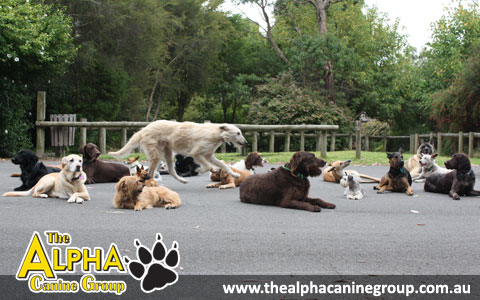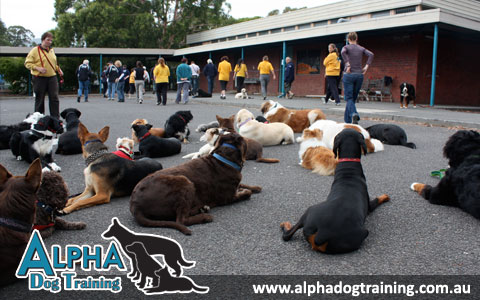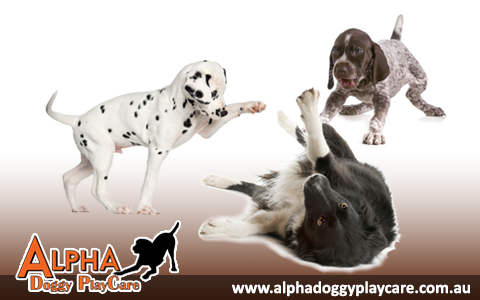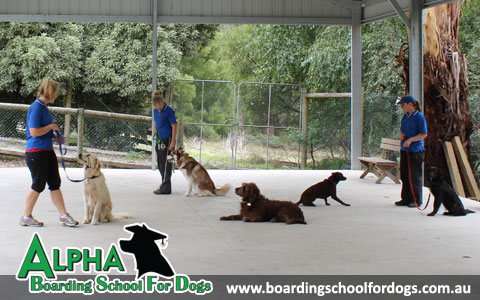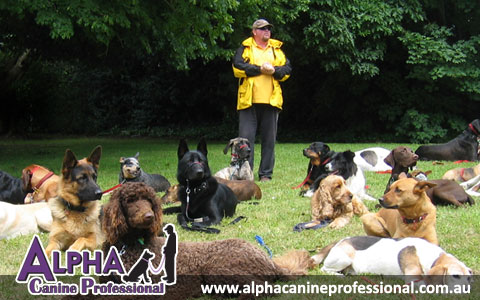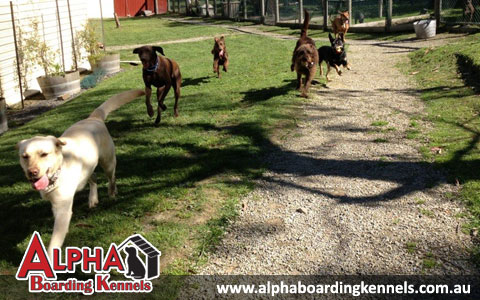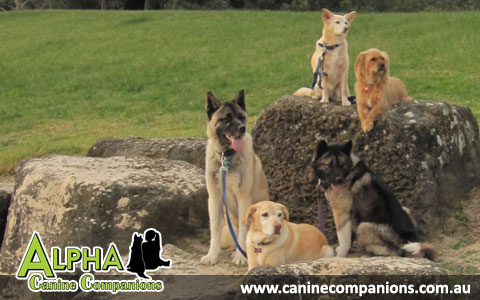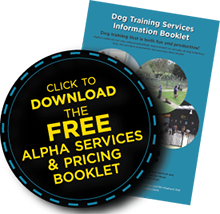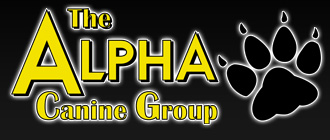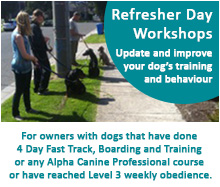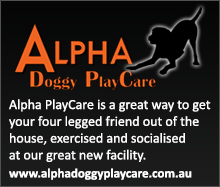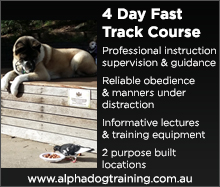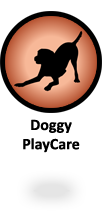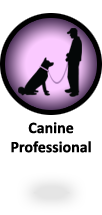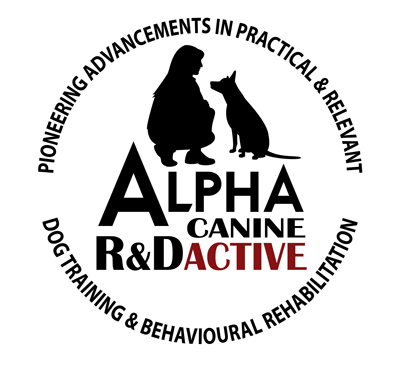
Alpha Canine R&DACTIVE
Real-time Canine Research & Development
Helping REAL owners of REAL dogs with REAL behavioural problems by applying our proven, effective and realistic techniques and strategies!One of the major benefits of The Alpha Canine Group's approach to ongoing, active research and development (what we call R&Dactive) is the fact that through the six separate businesses we are able to assess in real time various service, teaching and training initiatives in more than one practical application. This means that we can easily identify consistencies or inconsistencies in any facet of obedience training or behavioural rehabilitation, for example, rather than trying to make assumptions based on limited or no practical experience.
This has given The Alpha Canine Group a wealth of experience based on hands-on testing of both techniques and strategies relevant to each business individually and then also to the group as a whole. The skills, knowledge and results gained through this collective experience has helped to confirm the direction that ideals and ideas should proceed and has also opened up the most wonderful opportunities for exploration into other directions we would never have thought possible without the R&Dactive approach.
Some of our most exciting innovations have been the result of some very interesting realisations that have occurred during the R&Dactive process. Our unique approach to training certain obedience commands, revolutionary class structures and the development of truly consistent methods within the training system, have all undergone years of rigorous development in many different situations and applications. The fruits of our labour are the results that consistently come our way when helping people to understand and train their dogs.
R&D History
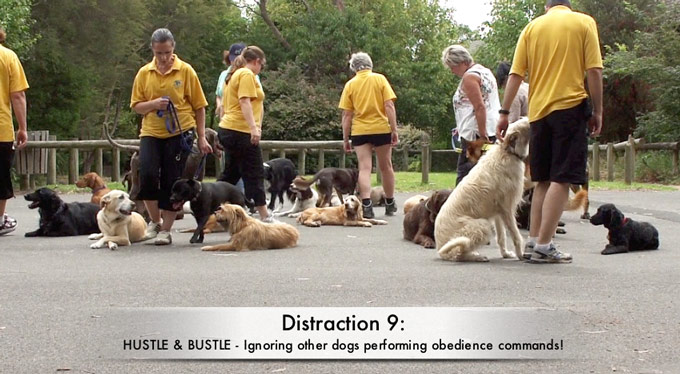
Above: This picture was taken from a video of 20 dogs belonging to Alpha trainers, trainees and customers holding a Drop Step-away (Stay) for about 45 minutes whilst 14 different distractions were presented over that period. This standard of obedience is relatively easy to teach and the benefits to the owner and dog relationship are endless. The distraction pictured here shows other dogs being worked in obedience whilst the dogs hold their Drop position despite the hustle and bustle going on around them.
Introduction (this is a relatively long document)
Below is a background document for the series of articles published in The Alpha Canine Group's online newsletter entitled: What Are You Really Teaching Your Dog. These articles expose many of the problems associated with training puppies and dogs using 'positive reinforcement-only' methods that are over-reliant on food rewards and often leave owners stranded with problem pets.
Training your dog is a lot of fun, but it must have a greater purpose beyond unreliable obedience tricks in exchange for food treats! Your dog's social and behavioural development is in your hands and without genuine leadership based on trust and respect, many of life's distractions can trigger over-reactions and unwanted behavioural outbursts that could so often be avoided or quickly resolved with proper and more balanced training methods.
The Alpha Canine Group has, since 1996, conducted extensive hands-on research and development into genuinely progressive dog training methods that are positive, relevant and practical for owners who need to manage their dogs' behaviour in their homes and in the communities in which they live.
The terms relevant and practical are every bit as important as the positive description of any dog training method, but these concepts are not necessarily fundamental to many training approaches that promote positive reinforcement whilst avoiding the use of a positive and contrasting correction process when teaching obedience, manners or during behavioural rehabilitation.
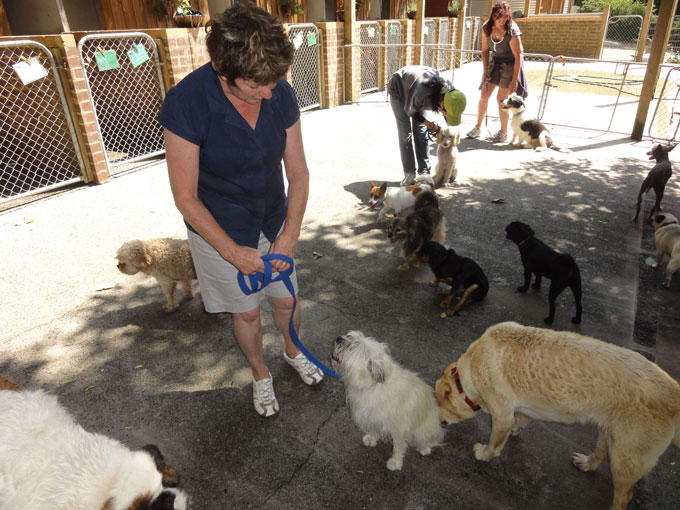
Above: These trainees attending a short-intensive dog trainer course run by Alpha Canine Professional are learning how to train and demonstrate dogs under distraction. These are important skills they will pass on to dog owners. Teaching dogs to listen when distracted, without relying on food lures or food rewards, is an important precedent to set in the owner and dog relationship. If you can't teach them to listen during obedience when distracted, then you can't expect them to learn how to behave when distracted. Contrasting corrections are used if and when required, but the dominant part of the learning equation is the praise and a voice reward (release command).
Positive reinforcement and reward are incredibly important ingredients of the learning process, but presented on their own, without a negative contrast, only allows owners to teach their dogs half the learning equation. Puppies and dogs learn so much more, and much quicker, and to much higher and reliable standards, even when distracted, when there is a positive, contrasting correction process that clearly pinpoints unacceptable responses or behaviour in a manner that clearly teaches them the acceptable alternative. This creates what we here at Alpha call "the positive outcome!"
Teaching puppies and dogs to recognise what they are doing right as well as what they are doing wrong makes so much sense and the positive outcomes achieved by this approach are reflected in both reliable obedience and good manners. This standard equates to a family pet that can be controlled if and when required, even when distracted or misbehaving during the various stages of the training process. With balanced training methods (positive, contrasted to negative) this control can be achieved even during the beginner stages of training and rehabilitation. This can be easily demonstrated!
Correcting dogs, when required, during training or for unacceptable behavioural choices has come a long way when compared to the dated and aggressive techniques of the past, such as forcefully pinning dogs to the ground, yelling aggressively or beating them. However, there are many in the industry who emotively generalise all correction and punishment processes as being the same - this is very misleading. There are modern and positive methods of correction that defy popular interpretation of the findings from punishment studies that were so often based on the aggressive and dated approaches. Even modern studies have a positive bias, rather than a balanced approach to researching the affects of punishment on animal behaviour. This point will be discussed later in this document and in future newsletter articles.
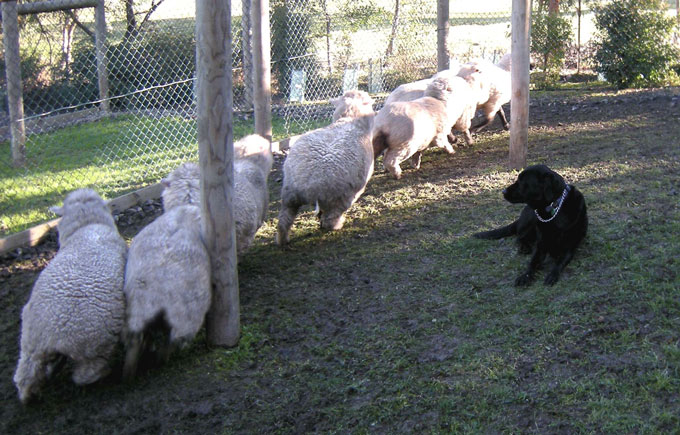
Above: This dog is holding a Drop Step-away (Stay) under a very high level of distraction. We had 20 days to prove to authorities that he could be rehabilitated for chasing and mauling sheep it was literally a life or death scenario if we failed. The methods used included a contrasting correction process that focused heavily on the praise and a voice reward we do not use electric shocks to punish dogs for chasing the sheep. The corrections did not break the dog's spirit or create aggressive outbursts towards the handlers (or the sheep), as is often predicted by objectors to any form of physical correction, again, because it is the contrasting praise and reward that does all the shaping. This important precedent of learning is first established when teaching reliable obedience. The end result was a dog that could roam free with the sheep in a yard whilst the trainer and council ranger who was conducting the assessment left them alone exiting the yard and leaving the dog behind (running free) without direct supervision. Needless to say the ranger was impressed by the happy and confident dog that now showed no interest in chasing sheep and the dog is still alive!
Experts promoting positive reinforcement-only methods would say that this predatory aggression is impossible to rehabilitate and that the physical corrections required would need to be so harsh that the dog's life wouldn't be worth living. The results speak for themselves and this beautiful dog can be seen in action calm and happy, not mauling sheep on one of the Boarding School For Dogs videos on our website.
It's time for a change in the way we assess what is best for our dogs when it comes to training and rehabilitation, particularly in relation to what they actually need in order to become safe and sociable members of our families, and out in our communities where they will meet children, other dogs, other animals and will be exposed to any number of stimulating and challenging situations. Positive training should prepare owners and their dogs for these real-life possibilities, not just unreliable obedience tricks for treats.
I hope the series of articles in our newsletters promote the understanding that there is a genuine need for demonstration and validation to be introduced into the debate about dog training that thus far (for at least the last 30 years) has been based on a simplistic, emotive and dated dichotomy of positive or negative theory.
We should no longer ignore the problems caused by positive reinforcement-only training methods. Owners need to question the experts and expect confident answers that are based on demonstrations, with real dogs, of how their method is both positive and relevant to the management of their dogs' present and future behaviour.
The information presented in the series of newsletter articles, along with the document that follows, offers an alternative approach to training dogs in a manner that makes so much sense when it comes to preparing them to live in our human world.
Greg Fontana
Training Director
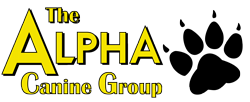
Melbourne, Australia
[ Back to Top ]- A little perspective goes a long way not all dog training methods are the same!
- The not-so-positive experiences of thousands of dog owners can't be ignored.
- Not a one-trick pony the cross-pollination and validation of ideas
- Observing & assessing canine behaviour within the owner and dog relationship insights on canine behaviour from another perspective
- Training to either prevent or rehabilitate serious canine behavioural issues
- Canine learning and behavioural theory, it's all in the interpretation what sounds good in theory isn't always practical or relevant in reality!
- Studies on canine behaviour are only part of the picture
- Alpha R&D governed by the real world
- Examples of Canine Learning and Behavioural Principles developed in reality with real owners and their real dogs that are often dealing with real behavioural problems!
- Speaking your dog's language
- Contrasting Corrections the positive power of "No!"
- Pattern, contrast, precedent, relevance & consistency
- Conclusion
A little perspective goes a long way not all dog training methods are the same!
Never assume that all dog training methods are the same, or that methods stating to be positive are necessarily going to be positive in the long run for you and your dog. There's a lot more to positive methods than just rewarding dogs with food or not using physical corrections.
Every dog, not just the 'bad' dogs, regardless of age, breed or disposition, requires proper and balanced training in order to prepare it for the realities of our 'human' world. Dog training is great fun, but it also needs to be done with the purpose of preparing owners and their dogs for realistic and distracting scenarios that confront them on a daily basis. Training for fun and games alone will not teach owners the skills needed to read and shape their dog's constantly evolving behaviour especially in the first three years.
Even the happiest dogs can develop serious behavioural problems if left to their own devices we hear this literally every day from concerned owners who suddenly see another side to their dog's general, care-free behaviour. In many of these cases the dogs have been previously trained with food reward methods that were promoted as being best for the dog. Happy-go-lucky dogs need to behave and listen to their owners just as much as behaviourally challenged dogs, especially when they become excited, startled or suddenly feel threatened these situations can and do occur without warning and affect the behaviour of any puppy or dog.
It is at that moment in time, and there will be many along the journey, that the training methods you have chosen for your dog will have either taught it to listen to you, or taught it to ignore you! Which precedent would make more sense when training your puppy or dog to be safe members of our families?
When choosing positive dog training methods you can either choose methods that are over-reliant on food rewards and allow your dog to misbehave and ignore you at will without meaningful corrections for doing so, or methods that use more practical rewards (voice) and correct misbehaviour in a positive (and meaningful) manner that also teaches them to listen and behave under distraction behaviour that is then lavishly rewarded.
Which approach do you think is more realistic and will produce the most relevant and overall, positive outcome of a happy dog that is well trained and behaved around children, visitors, other animals, or any other common life experiences?
In the end, there's one easy way to decide ask the experts for explanations that are backed up by relevant demonstrations, with their own dog, and your dog, that show an immediate and common-sense relevance to both your dog's current and future learning and behaviour.
You have every right to ask for this, you should ask for this, and the experts should be happy and proud to demonstrate the relevance of their methods!

Above: This picture has been taken from a video on The Alpha Canine Group's Facebook page. Allowing our dogs to run, play and socialise is one of the most fun activities shared by owners and their dogs. In this particular group of about 40 dogs there are breeds ranging from Chihuahua to Akita (the amount and breeds are always different in these socialising groups), and there were dogs new to this hustle and bustle still on lead so they could be taught how to behave without going over-the-top with their excitement. These dogs belong to Alpha Dog Training trainers and trainees, have been trained properly and are having as much fun as any other dog, but the owners have control if and when required. This is also an example of trainers who have their own well trained and behaved dogs with them when they teach we call this important standard Leading By Example! Many of the trainers in this group are managing more than one dog.
The not-so-positive experiences of thousands of dog owners can't be ignored.
Since its inception back in 1996, The Alpha Canine Group has consciously stepped away from popular and mainstream influences within the dog training industry, and has instead over that time pioneered exciting and new canine learning and behavioural principles based on active, 'hands-on' research and development with over 10,000 owners and their dogs (between 1996 2012). This amounts to substantial interaction and personal feedback from many owners and their dogs from all walks of life, all of which was, and still is, coming from multiple training and boarding services. This combined experience and feedback has given Alpha a unique perspective on canine training and behaviour, and an overview of the realistic needs of dog owners in our modern societies.
Training dogs with food reward methods that were based on scientific principles was gaining popularity at quite a rapid rate when Alpha started out, but the decision was made to move away from these methods because of the continued feedback we were receiving from owners who had tried to follow the positive reinforcement-only approach, an approach that usually excluded any meaningful correction process, only to find that their pups and dogs continued to develop serious behavioural issues. In virtually every case the obedience taught with food rewards was to a very basic standard, especially when the dog was distracted, and there seemed to be an incredibly permissive approach to training that actually set a strong precedent for more general misbehaviour.
It should also be noted here that there was rarely any form of demonstration by the experts showing the results of their training and in the vast majority of cases the experts' own well trained and behaved dog was not seen by the client. This was the general standard in our industry at that time and not a lot has changed on that front in the current day. On that note alone, dog owners should be wary of 'dogless experts' who only demonstrate with an imaginary dog, if they demonstrate anything at all, rather than the real thing. Dog experts should teach and demonstrate with their own well trained and behaved dog at their side in classes or private consults!
For all the good these positive methods were meant to be doing, they were actually having a completely opposite affect on far too many dogs. It had become obvious that many owners were being stranded with problem dogs after trying positive, food reward methods, and the overall outcome was far from positive. This was especially true as puppies matured and became adolescents or adults. All of a sudden the food rewards weren't that important to a dog that had learned to experiment freely and was now too busy misbehaving or too distracted to listen to its owner.
It is at this point that a puppy or dog becomes what we call a behavioural time bomb, just waiting for the right (or wrong) conditions to over-react and explode.
Uncontrollable dogs, no matter how happy and friendly they are, can over-react to common situations and stimuli that confront them on a daily basis. This is when many dogs experiment with behaviours such as aggression, fear, anxiety, or they become more and more excitable and out-of-control, often because the owner has inadvertently demonstrated through permissive training approaches with low standards, or through no relevant training at all, that they are not the leaders in their dog's eyes.
Important note: Leadership is an important factor in the owner and dog relationship that develops both respect and trust in a positive manner. This can be easily demonstrated with balanced training methods!
In short, what we were hearing from owners and seeing first hand was the lack of training and control under distraction combined with the lack of a meaningful and positive correction process when the pup or dog misbehaved even if it misbehaved during obedience training or behavioural modification. This equates to a bad recipe for rebellious canine behavioural problems. Experts were (and still are) placing too much emphasis on allowing the pup or dog to freely experiment during the training process, even if this experimenting included problem behaviour or blatantly ignoring the owner, whilst the owner waited for the dog to offer some good behaviour to reward it. This approach was now being considered as a more scientific learning process because it was based on the methods used in operant conditioning experiments published by B.F. Skinner way back in the 1938.
The dog training world was now trying to emulate and apply scientific practices that had been conducted in laboratory settings, but the dogs were often resisting the science due to the real-life distractions competing for their attention. Food was a powerful reinforcer in the laboratory, but not necessarily so in the outside world!
So, despite the positive ideals and scientific foundations behind these methods, literally thousands of owners, along with their dogs, were showing us that there were fundamental flaws in the positive-only training methods. This fact could not be ignored, so when the decision was made by Alpha to look into alternatives, it led to a fundamental guideline for all of Alpha's ongoing research and development:
Don't just focus on the positive theory of method, focus also on the positive and practical relevance of method and validate everything through 'hands-on' demonstration.
In other words, make sure the method makes practical sense to the owners and is effective on virtually all dogs (happy, fearful, aggressive, anxious or over-excitable).
The positive outcomes (results) will validate the theory!
Since those early days we haven't looked back and we are so proud of the theories, principles and methods that we have developed outside of the academic or scientific approach. Whilst we have taken note of the science, we haven't been shackled by the chapter and verse of textbooks, instead we have looked beyond the findings of scientific studies to see if we could find what, if anything, was missing from the theories and interpretations on canine learning and behaviour. It was this objective assessment of the science, from a real-life perspective, that steered method development into other non-academic directions.
What follows is an overview of how we have gone about our research and development, and as you will learn, a lot of hard work and thought has gone into producing positive dog training methods that are reward based and include a meaningful and positive correction process, methods that are relevant and practical when the dog is distracted or misbehaving, methods that make sense in the real world methods that can be demonstrated, from the very first session, to actually work!
Demonstrations make it so much easier to explain how the learning principles will continue to be effective through the maturing process, and of course, we can always show dogs that are a product of the methods at various stages of training and rehabilitation from puppy and beginner all the way to off-lead levels all under distraction!
[ Back to Top ]Not a one-trick pony the cross-pollination and validation of ideas
The Canine Leadership System was formed with a deliberate focus on the synergy produced by the combination of consistent and practical insights coming from working with these thousands of clients and their dogs in the different teaching environments provided by Alpha's training services. These settings include:
- Weekly obedience classes, where canine learning and behavioural patterns were tracked through puppy, adolescent and adult development
- Private tuition, where canine behaviour was observed in the home environment
- Boarding school settings, where canine behaviour was observed in both the home and boarding environments
The synergy generated from the information and hands-on experience gathered in these settings is an important and fundamental aspect of system development, and when reviewing the history behind all of Alpha's methods, strategies and ideals, it is clear to see that it has been an important catalyst in creating unique opportunities for the observation, assessment and refinement of canine learning and behavioural theories and principles.
Alpha Canine R&Dactive is the name given to The Alpha Canine Group's ongoing research and development and it combines all the feedback and experiences related to us by owners about their dogs with the results from the teaching and application of our methods used to help them understand and manage their dogs' behaviour in real-life situations.
[ Back to Top ]Observing & assessing canine behaviour within the owner and dog relationship insights on canine behaviour from another perspective
Alpha's experience with dogs has also come from within the boarding kennel environment. This environment has allowed us to observe and understand canine behaviour from a more intimate and personal perspective that could not be achieved when working in other situations. With the dogs staying in our care we are not only able to observe behaviour that would normally only be seen by the owner, we also observe behaviour that the owners don't see or perhaps recognise in the home environment.
This insight alone has had a dramatic impact on understanding canine behaviour, particularly aggression and anxiety. Comparisons between behaviour at home and away from home often shows us another side to the dog, highlighting potential for rehabilitation that would either not be recognised, or would be completely ignored altogether in other approaches. We also found that many owners were misinterpreting their dog's behaviour, but when this was explained (and demonstrated) they could see another side to their dog's ability to learn and behave, with much more potential.
From these insights we have learned to look for relationship markers between the owner and their dog that would never be picked up in questionnaires, regardless of how detailed they are, because the questions are often based on what the owner thinks they are seeing, which can often lead to answers based on misinterpretations. The owners themselves would also often be unaware of their own behaviour and its direct relevance on the dog's behaviour. These interactions, left unchecked, can and do lead to serious behavioural issues that can often be avoided.
All this has lead to Alpha's Real-time Behavioural Assessments, where we assess the relationship based on actual owner and dog interactions that then ultimately help us to offer advice that produces real-time (immediate) behavioural improvement. Regardless of which training service we offer, all the experience gained from other services in the group has helped to form the questions we ask and how we assess the owner and dog interactions. The greater experience and relevant knowledge from within The Alpha Canine Group combines during discussions with owners about their dog's behaviour or when working 'hands-on' to solve a particular training or behavioural issue.
This is why we can often achieve positive outcomes with dogs that have failed with other attempts at training or rehabilitation we have seen canine behaviour from a very different perspective to others in our industry and we know, from experience, how to use this information to prevent or rehabilitate canine behavioural issues.
[ Back to Top ]Training to either prevent or rehabilitate serious canine behavioural issues
Under the guidance of Training Director, Greg Fontana, many new training techniques and strategies have evolved since 1996, again, contrary to much of the popular behavioural theories that just didn't seem to correlate with actual dog behaviour in the real world. This point was particularly relevant to those dogs that were exhibiting behavioural issues such as aggression, anxiety, fear or over-excitability, or the large number that weren't motivated by, or weren't responding to, popular food reward methods. Again, from the feedback we receive from thousands of owners who have tried food reward methods, it appears that the number of dogs falling into these categories is much greater than many people realise.
The objective assessment of all this feedback has over the years lead to many practical advancements in the development of relevant canine behavioural rehabilitation. But more importantly, it also helped to define and refine the often-overlooked concept of preventative dog training that teaches owners to recognise and interrupt the onset of serious and unacceptable behaviour during canine social and behavioural development. These are skills that can't be taught with methods that are both over-reliant on food rewards and avoid the use of meaningful corrections.
At Alpha we believe that all puppies and dogs should be taught with preventative training methods as preparation for the common challenges affecting all owners and dogs in the real world. By focusing on prevention, wherever possible, we are better placed to avoid the need for rehabilitation.
The Canine Leadership System, at its heart, demonstrates the importance of both the prevention and rehabilitation of unacceptable canine behaviour. It is the development of training methods for the prevention or rehabilitation of serious canine behavioural issues that has taught us to focus on reality, relevance and practicality.
[ Back to Top ]Canine learning and behavioural theory, it's all in the interpretation what sounds good in theory isn't always practical or relevant in reality!
Has the dog training world lost its way? Is there too much emphasis nowadays on academic theory and not enough hands-on validation of dog training methods to prove that they even work? Is a method truly positive if the theories applied are unable to produce consistent, positive and relevant outcomes for owners and their dogs? Why are more and more breeds and crossbreeds being considered difficult to train, or common canine behavioural problems becoming too difficult for experts to prevent or rehabilitate?
Consider the following points when listening to opinions or reading quotes from studies relating to canine learning and behaviour that are often used to promote positive reinforcement and food reward methods as being best for the dog, or those that denounce any form of physical corrections in the training and rehabilitation process by generalising all physical corrections as being the same. This is by no means a definitive list, but these points are all relevant when teaching dogs reliable obedience and good manners that are essential in preventative training, or when working through behavioural rehabilitation.
On the effects of food rewards:
- Not all dogs are motivated by food many, many are not!
- Even food-motivated dogs ignore the lure or reward when distracted in day-to-day scenarios the following points expand on this reality.
- Many canine behavioural studies are conducted in unnatural, distraction-free settings, not real-life settings, such as the home or the local park that are full of distraction that is relevant to how your dog learns and behaves.
- The findings of any study on canine learning and behaviour that has been conducted in contrived settings and situations are severely compromised when applied to random, real-life scenarios.
On the effects of physical punishment:
- Not all physical correction and punishment processes are the same.
- Not all physical correction and punishment processes have been researched.
- Not all physical correction and punishment processes focus on the negatives.
- Reinforcement Contrast Effect and Contrasting Corrections create and focus on the positive alternative (obedience response or behaviour).
- Piecing together findings (theories) from separate studies on different and specific aspects of canine learning and behaviour can severely alter the original theory that was researched in isolation.
For example: Researching punishment as a singular principle without a positive contrast renders the findings of such studies (on the negative side-effects of punishment when applied on its own) irrelevant to modern methods where positive reinforcement is combined with the punishment the positive reinforcement being the dominant aspect of the learning equation!
Over the years many experts in the industry, ranging from dog trainers to academic and veterinary animal behaviourists, have cited scientific studies to justify their positive stance on the use of food rewards and their objection to the use of any form of physical corrections in the training or rehabilitation process. However, owners often relate to us the description of methods advised by these experts that seem to focus more on theory rather than the actual demonstration of positive outcomes relevant to the dog's training or behavioural issues.
This is a very important point to make. There is a lot of theory and opinion in our industry, but very little demonstration of how the methods based on such theories are relevant to the day-to-day training, rehabilitation and overall management of a dog's behaviour! As mentioned earlier, often the experts themselves don't even have a well trained and behaved dog with them when they teach or consult dog experts without demonstration dogs that can accompany them virtually anywhere to validate their methods to the owners they are advising. Their theories should at the very least be reflected in the standard of their own dogs!
The studies often cited are open to a lot of interpretation and the findings can often be disputed when comparing laboratory behaviour with real world behaviour, especially in relation to dogs. You can also question:
- The criteria for animal selection (was the dog food motivated or non food motivated, for instance? this can influence the relevance of a study on how dogs learn with food rewards).
- Were the dogs selected of certain breed or temperament?
- The specific methods used or compared in particular studies certain methods may work on some dogs and in some training situations, but not when applied in real-life scenarios full of distraction.
- Did the studies compare results under different levels of distraction?
- Why only certain aspects of behaviour were measured and not others.
- How restrictions from an ethics committee or financial constraints compromised the scope and overall relevance of the study. These restrictions can be relevant to the omission of many real-life factors affecting a dog's ability to learn or on its behavioural reactions not being able to measure a dog's learning or behavioural response to noisy and erratic children playing nearby for instance, because it is unethical to place children in potential harms way if a dog reacts boisterously or in an aggressive or menacing manner to their presence. However, in real-life the presence of children can affect how a dog behaves or responds to obedience commands.
I have personally consulted on one particular university study on canine behaviour where both financial and ethical constraints dramatically affected the scope of the study to a point that severely compromised the relevance of the data collected. There were so many relevant situations omitted that what was left was a token representation of the behaviour being measured. There is no way at all that the data gathered in this study could be generalised and made relevant to real-life assessments of a dog's behaviour there were just too many omissions and loopholes in the contrived scenarios used to collect the data!
The list of relevant questions is endless when you are looking at the information from a real-life perspective that is, the relevance to real owners and their real dogs in relation to the day-to-day stimuli that will affect the dog's behaviour during the learning process.
For instance, to say that scientific studies have proven that using food rewards is the most effective way to train dogs, the first thing that comes to mind is what constitutes training? What exercises were taught and in what scenarios? Is it simply teaching an exercise in a quiet scenario with a food motivated dog, or is it teaching a reliable response in a bustling scenario likely to be encountered in the real world (such as erratic children playing nearby, or other dogs chasing balls nearby, or chickens fluttering nearby) with a dog that is not that interested in food rewards? Even if measuring the learning process with a food motivated dog, was the food reward still effective when the dog was distracted?
The effects of learning from behavioural studies need to be measured or at least compared in real-life scenarios to see if the findings are relevant to the real world. These studies can't be taken on face value, just accepting that the experiments provided relevant data. Unless the findings can be translated into methods that affect change in the dog's behaviour when in scenarios that are relevant to its learning problems or specific behavioural issues, then the findings need to be categorised as specialised.
I'm not challenging scientific studies just to be different or difficult, I'm challenging the findings because these and many other points are relative to the owner trying to teach their dog reliable obedience and good behaviour in the distraction of the real world. My questioning comes from the experience of working hands-on with thousands of owners and their dogs that have resisted countless food reward methods, methods that have been based on theories and principles developed in scientific scenarios, not real-life scenarios. Interestingly, in discussions with other professionals who work hands-on with dogs I have had this same feedback the positive theory doesn't work when a dog is distracted!
When it comes to citing behavioural studies as proof of training or rehabilitation techniques, the validation of a chosen training method still needs to come from the practical interpretation and application of the information, and the demonstration of positive outcomes for owners and their dogs. Implying that a method or style of training has been proven by science would be impossible because behavioural studies are often too limited in their scope, which then renders the information as being specific to certain dogs similar in drive and general behaviour to those used in the study and only in specific situations that may be similar to those created within the study.
The same could be said in relation to studies on the effects of punishment on a dog's ability to learn, or on how it reacts or behaves when punished. There are so many emotive and negative generalisations made about punishment, but not a lot of objective analysis of the variables affecting the studies. Variables such as:
- The type of punishment applied.
- The intensity of the punishment applied.
- Was the punishment delivered and measured as a singular principle (punish the dog and see what happens) devoid of any contrasting positive reinforcement?
- Was the punishment delivered in the same manner for each dog? There are so many variables relevant to this question!
- Was the punishment delivered as part of a deliberate method where the acceptable, alternative behaviour could be shaped and rewarded?
- What were the specific training or behavioural scenarios for which punishment was applied? What reaction, response or behaviour caused the dogs to be punished?
- Were the findings collated from answers to questionnaires by dog owners answers based on their individual understanding and potentially subjective assessment of punishment and the effects it had on their dog?
- What dogs were selected or rejected for the study and why?
All these points, and many more, are relevant questions about the findings of any behavioural study focussing on punishment. Again, these and many other variables are relevant when assessing how the findings of a particular study should be interpreted if they are to be applied to dog training methods.
To imply that all the studies conducted to date on food rewards and physical punishment form a definitive picture on the best practices when it comes to training or rehabilitating a dog is unrealistic at best. On that note, generalisations about the effectiveness of food rewards as opposed to the harm of punishment in the learning process are often unfounded when logic and perspective are used to assess how various findings translate into the real world that affects owners and their dogs.
These points are relevant to the many dogs that are misdiagnosed because they don't fit into the pigeon holes created by the popular interpretation of canine learning and behavioural theory. There have been many reports of behavioural experts labelling canine behaviour as abnormal or beyond help when an alternative perspective based on hands-on research and development has actually affected positive and lasting change in the dog's behaviour.
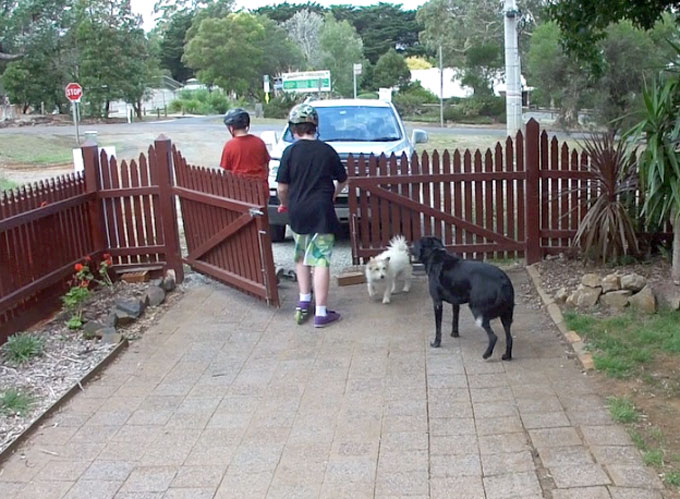
Above: This picture was taken from a video showing the importance of good manners in the training and rehabilitation process. These two dogs were given up by their previous owners because they were too difficult to manage. One was over-excitable and out-of control and the other was really timid. With proper training they have learned reliable obedience and reliable manners not running out the open gate, or jumping all over the children for instance. Managing and rehabilitating problem behaviours requires methods that are positive, but they must also provide a contrasting correction process that is meaningful to the dog so they can be clearly taught which behaviour is right, and which is wrong!
Studies on canine behaviour are only part of the picture
Behavioural science has definitely helped to understand the processes of learning, but it serves more as a guide for further exploration through application in real-life situations. When you work with owners and their dogs hands-on and in real-time, as we do here at Alpha, you start to assess the information from various studies quite differently it is either directly relevant to the owner and dog, instigating positive, relevant and lasting learning and behavioural changes, or it is not.
Behavioural studies often explore learning or behavioural theories only in part, not as a whole not in a manner that is directly relevant to the many variables causing a dog to jump on the children, bark at visitors, or chase the cat. Studies are conducted this way due to the complexities of measuring all the random behaviours, responses and reactions coming from the dog/animal in any given situation. Instead they focus on a specific set of criteria and create unnatural environments and situations that will best stimulate target behaviour in a manner that can produce and reproduce the relevant and consistent data that falls within the research parameters. Real-life distractions that influence behaviour beyond the scope of the study are avoided, which by default, detracts from the potential relevance of the data when extrapolated and then applied to dogs living and reacting to an outside world full of distraction.
Another real-life discrepancy we found with various studies on learning and behaviour is that because they are focussed on exploring specific and isolated principles in very unnatural settings, the piecing together of the fragmented data (theories) from these individual studies doesn't actually make a complete whole. It can't be assumed that piecing together theories that were developed in isolation of each other won't then affect the original findings. There would need to be further studies on the effects of these theoretical combinations.
This is the complete opposite of Alpha's synergistic approach described earlier, where the whole is greater than the sum of its parts. We assess all the learning and behavioural interplays as they occur, whether the dog is responding to an obedience command one minute, or over-reacting to a distracting stimulus the next. By reading and assessing the dog's learning ability and behavioural responses as a whole, relevant to the situation and any distractions, you can develop theories and principles that are more likely to have a relevant impact in real-life scenarios.
Alpha R&D governed by the real world
The Alpha Canine Group's research and development into new methods and principles is very different from the strict scientific approach, but our findings are no less important or valid when compared in reality. To be honest, it could be argued that the Alpha approach is more valid due to the ability to demonstrate and consistently reproduce positive, effective and relevant outcomes in real-time, working 'hands-on' with owners and their dogs under realistic distraction. Alpha has always based their methods on positive outcomes that can be demonstrated on virtually any dog, regardless of their behavioural limitations or previous resistance to other methods of training and rehabilitation.
We successfully achieve this ideal on a daily basis and can explain and demonstrate positive and relevant principles in real-time working with real owners and their dogs. Demonstrating our theories and principles is an important part of the teaching process!
The approach taken by Alpha Canine R&Dactive is to develop theories and methods based on the dog and its behaviours, responses and reactions within the hustle and bustle of the real world. We have chosen to observe and define the whole, under distraction, not individual parts of the whole in isolation away from distraction. Dogs live in distraction! We actively observe these before-mentioned responses and reactions to the unpredictable and varied stimuli in different and novel situations. It is working with owners and their dogs whilst contending with these real-life variables that brings relevance to Alpha's principles. It is a relevance that can be measured by the results of our methods in the short, mid and long term.
This is not strictly scientific, but it works. We have been able to develop theories, principles and methods that can be consistently demonstrated to be relevant to real-life scenarios and reproduced on virtually any dog.
From this focus on relevance we identified a basic need for the consistency of communication across what we consider to be the three disciplines of training dogs for real-life Leadership Obedience, Canine Good Behaviour Shaping (manners) and when required, Canine Behavioural Rehabilitation.
[ Back to Top ]Examples of Canine Learning and Behavioural Principles developed in reality with real owners and their real dogs that are often dealing with real behavioural problems!
At Alpha we have developed new and exciting approaches to dog training and behavioural rehabilitation that defy the academic understanding of how dogs learn when distracted. Whilst the majority of dog training methods avoid distraction, we have deliberately worked with dogs within distracting scenarios, in recognition of the fact that this is when owners need to be able to control their dogs the most.
What follows are a few insights in relation to Alpha-developed principles that can be demonstrated on virtually any dog and in virtually any situation. Yes, there will be exceptions to the rule, but these exceptions are few and far between.
1: Alpha-developed principles: Speaking your dog's language
Observing a dog's behaviour and its affect on learning ability whilst under realistic distraction requires an understanding of how to interpret and respond to behavioural change as it occurs. Variables such as the intensity of the behaviour and intent behind the behaviour are continually fluctuating, but both are also contingent on the learning that is taking place amidst the competing distractions of any given situation. The dog's learning ability is fluid and it is constantly changing. This places a huge importance on what we call Precedent Of Learning, which then has a profound and ongoing affect on a dog's behaviour under distraction.
It is this realisation that promoted the exciting evolution of Alpha's methods based on a consistent language framework that has been developed to take into account the dog's random behaviours, responses and reactions in real-life scenarios.
This language framework is ground breaking to say the least.
The specific development and consistent use of language in the obedience training, behaviour shaping and rehabilitation process was born out of the need for instant and recognisable communication between the owner and their dog in distracting, real-life situations.
This Alpha-developed principle is now called Canine Cognitive Tonal Conditioning (CCTC) and it is reshaping many of the current ideas on a dog's cognitive ability to recognise and understand the meaning of varying tones of voice within the varied phrasing of obedience commands and verbal reinforcement markers ("Good Boy" or "NO"). All this is achieved under distraction!
Canine Cognitive Tonal Conditioning takes the concepts of 'consistency' and 'relevance', in relation to dog training, manners and rehabilitation, to an entirely new level. Because the language framework was developed for use as a genuine communication process beyond the original obedience application, it has opened up possibilities that would never have been considered without the conscious effort to transcend such limited use (in obedience).
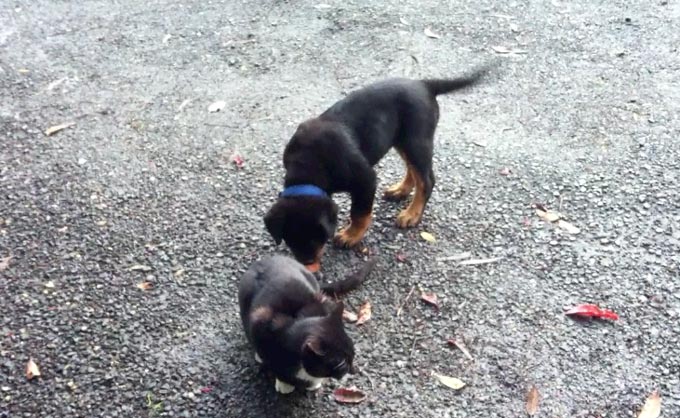
Above:This picture was taken from a video showing the importance of teaching puppies how to recognise the different tones of praise. Teaching puppies how to listen and behave when they are distracted or excited not only makes them much easier to manage in these situations, but it also helps to teach them manners. Once language has been established in the first two obedience exercises, even for tiny puppies, the tones of praise can be used in many different teaching scenarios, ranging from manners to socialisation, and if required, behavioural rehabilitation. This 9 week old pup learned very quickly not to run out the open gates, to come inside only when invited even if the door was open or the children were coming in and out, not to jump up until invited, not to bite the children, not to chase the cats, not to carry-on when left on his own, not to jump on the glass door, and the language also helped with his socialisation to other animals such as sheep and horses.
At Alpha, the obedience is taught with the very clear intention of developing a language base that can then be used, if and when required, when the pup or dog is not in obedience mode which in reality is most of the day. Now obedience training has a greater purpose and relevance beyond the teaching of specific exercises or routines!
2: Alpha-developed principles: Contrasting Corrections the positive power of "No!"
Not all corection processes are the same and the research on punishment hasn't explored all the options!
Measuring negative reinforcement or punishment as a singular principle is not balanced or realistic and shows a fundamental flaw within a scientific approach that is potentially influenced to produce a subjective point-of-view favouring a preferred or popular opinion that is, all physical punishment is harmful to the dog and impairs the learning process.
This popular opinion is based on science that focused on punishment on its own, without a positive contrast, without the option of the animal being rewarded for offering a more acceptable, alternate behaviour or response.
Violently pinning puppies and dogs to the ground, striking and kicking, delivering electric shocks or relying on aggressive yelling to punish poor obedience responses or undesirable behaviour, are dated approaches to punishment.
Much of the research on the negative effects of punishment is focused on an extreme end of the learning equation and assumes that all positive (physical) punishment is delivered with aggression and ferocity, and without positive contrast!
It is often implied that training methods that use any form of physical corrections will break the dog's spirit and spoil their fun. This is not true! Puppies and dogs that are trained properly with contrasting corrections aren't robots, they are as fun-loving as any other dog, it's just that their owners have more control, if and when required, and the ability to shape good behaviour from bad experimentation.
This approach produces exciting and positive outcomes that are recognised in the immediate, mid and long term assessment of the learning process. There are many factors affecting the positive effect of punishment on a dog's learning or behaviour and it is simply wrong to focus on certain aspects of the learning equation without balancing them against others.
The use of physical corrections is a very emotive subject in our industry and by far the most popular approach by most experts is to avoid them altogether, even if this means allowing pups and dogs to ignore their owners and become more and more out-of-control. It is incredibly simplistic to assume that a training method is positive because it doesn't use "NO" or any form of physical correction, or that a training method is negative and harmful because it does use "NO" and physical corrections.
Positive is as positive does the proof is in the positive outcomes, not the theory or the ideals! The positive outcome is a happy puppy or dog that behaves and listens, if need be, when distracted.
Question the experts
It has become apparent over the years that the positive, food reward methods that avoid the use of any form or physical correction are based on positive ideals and theory, rather than an overall positive outcome for the owner and their dog. There seems to be a real discrepancy between theory and reality. We would encourage all dog owners to question any expert about the long-term purpose of their methods. The following questions will often expose potential lack of overall positive outcome:
Q: Ask your chosen expert how their positive dog training method works in reality around excitable children, visitors, other animals, at the dog park, on walks, around the home etc? Do they actually address these real-life issues or do they expect you to remove the dog from these situations?
Q: Ask your chosen expert how their positive dog training method prepares owners and their dogs for the real world full of common distractions that can, and do, promote the development of serious, unacceptable canine behaviour such as aggression, anxiety, fear and over-excitability?
Q: Ask your chosen expert how their positive dog training method directly prepares owners and their dogs for the common challenges that affect the social and behavioural development of all dogs, particularly in the first three years of their lives?
Q: Ask your chosen expert how their positive dog training method prevents the development of bad behaviour if it also allows pups and dogs to continually misbehave and ignore their owners without meaningful correction?
Q: Ask your chosen expert how their positive dog training method doesn't make problem behaviour stronger over time when they don't correct these problems in a manner that sees them extinguished (so they don't return)?
In reality, how positive is it for the pup or dog in the long run if the owners become increasingly frustrated because its pushy and demanding behaviour gets worse, not better, as it gets older?
The above questions, and there are many more depending on how deep you want to go, have been formed from the feedback of thousands of owners who have watched their puppies' and dogs' behaviour deteriorate despite using positive methods. These common issues arise when the use of any form of physical correction is avoided in the training or rehabilitation process and owners are told to instead ignore bad behaviour, or to wait for the pup to finally pay attention, and then reward the good behaviour.
This is a win/win situation for the pup or dog and it does not clearly teach them what they are doing is wrong. Owners are told by experts to ignore the dog's behaviour or withhold the food reward until the dog listens or behaves, and then the food is delivered with praise. Many owners have told us that their dogs' responses and behaviours don't actually improve, they get worse, all because the dog is not being taught both sides of the learning equation what is right and what is wrong! Ignoring the dog does not clearly teach what it is doing wrong!
When dogs are ignoring their owners or misbehaving, they don't care that they are being ignored or not receiving food treats, and as they get older this situation gets worse. Dogs are learning that there is no meaningful consequence for misbehaving and as a result they don't even know that they are actually misbehaving. As a pup matures it quickly learns that it can do as it pleases and before long they are primed to experiment with antisocial over-reactions and more extreme and unacceptable behaviour. We have heard this exact scenario from thousands and thousands of dog owners who had tried the positive reinforcement-only approach with passive corrections that eventually meant nothing at all to their pup or dog!
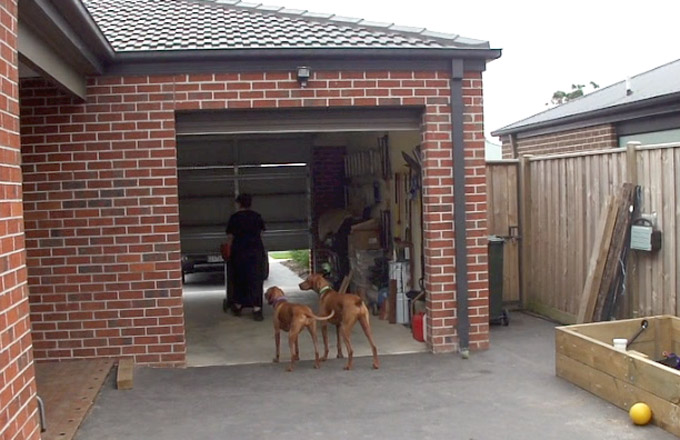
Above:This picture was taken from a video on the importance of Canine Good Behaviour Shaping (manners that really matter). Teaching dogs to observe boundaries, such as the front gate or roller door, especially when they are hell-bent on bolting through the opening and out onto the street, requires methods that make sense to the dog. Without the ability to correct the dog in a meaningful and positive manner with contrasting physical corrections would make this level of important and practical control virtually impossible. An important point to make here is that these methods are validated on dogs that are wilful, boisterous or with a history of resisting other methods, especially those that have relied on food treats and insisted on only passive corrections that meant nothing to the dog. These two dogs can also run freely in the front yard, staying on the lawn, without going on to the footpath or the neighbour's garden.
The Alpha Canine Group takes our client feedback into account when developing realistic training and rehabilitation methods. These methods have focussed on the need for positive outcomes for owners and their dogs and found that physical corrections could be used successfully when combined with contrasting positive reinforcement. This would never have been possible if we had just accepted popular theories without assessing real world relevance.
Reinforcement Contrast Effect is simply the contrasting of positive and negative reinforcement in a consistent manner that creates an overall positive outcome.
It should be pointed out that a well-timed "No" and appropriate contrasting physical correction that is taught to the puppy or dog as part of a learning process that is focussed on the contrasting positive reinforcement and (voice) reward is far more effective and positive to the dog's wellbeing and overall quality of life. Add to this the fact that impractical food rewards are not required in this process, not even for puppies, and that they learn to listen and behave under distraction.
This can all be so easily demonstrated with real puppies and dogs! Owners who see and experience this process are often amazed by the positive and relevant results (in obedience and behaviour) that occur right before their eyes! This is despite previous attempts at applying positive, food reward methods to no avail sometimes for several months or even years. This is especially so when they have been previously told that all physical corrections are bad, but then they see otherwise!
In some cases we have rehabilitated dogs that were given death sentences by veterinary behaviourists who had told the owners that their dogs were beyond help. One three year old dog in particular had been dog aggressive since it was a young puppy and had resisted all attempts at rehabilitation for this problem. An experienced behaviourist told the owner, a vet nurse, that the aggression was so ingrained that any form of rehab would be so intense that the dog's life wouldn't be worth living euthanasia was the kindest option!
At the first introductory session at Alpha Dog Training it took three contrasting corrections over a relaxed, ten minute period to see the dog go from intense launching at dogs at a distance to lying down and letting all dogs pass. The overwhelming part of this learning process was not the actual correction, it was the praise! Needless to say, the owner was horrified to think that she nearly destroyed her mate and he became a totally different dog from that time onwards.
We have many, many more examples like this where owners have been wrongly advised that their dogs are abnormal or beyond help, or that they should re-home their dog or have it euthanised! However, when leadership was established through clear and positive learning processes that included contrasting corrections, there has been a dramatic and positive change in the dog's behaviour!
Many dog experts are still bogged down in the limiting and out-dated mindset of positive or negative when it comes to applying reinforcement in canine learning and behavioural theory.
Alpha has redefined the learning equation by replacing positive OR negative with a much more progressive approach where the positive and negative reinforcement contrast against each other positive and negative and positive again the negative is a minor and diminishing part of the overall process. The learning outcomes from this approach are positive, quick and lasting, in obedience training, behaviour shaping and behavioural rehabilitation.
3: Alpha-developed principles: Pattern, contrast, precedent, relevance & consistency
Working with owners and their dogs under distraction and in different training scenarios has enabled Alpha Canine R&Dactive to develop and assess methods from an overall, realistic and relevant perspective. Again, this is very different to the scientific approach and it is because of this that we have been able to develop theories and methods that challenge many of the popular interpretations of academic findings on canine learning and behaviour.
It should be understood that the synergistic foundation of The Canine Leadership System has from its very beginning been set up to self-perpetuate creative change in line with the increased results in all areas of dog training, good behaviour shaping and behavioural rehabilitation. These results affect everything from training techniques and class structures, to instructor training and customer relations.
At Alpha, we don't copy we create, refine and innovate! Any techniques that were adopted from previous influences when we first started back in 1996 have almost universally followed a process of total change, adaptation or deletion!
To that end, it can be totally assured that the explanation of all terminology and its true synergistic relationship within the greater system would expose a virtual labyrinth of connections that are the result of much deliberate thought and purpose everything is linked together and any one concept or technique is not complete on its own especially out of context.
Nothing is named or re-named for the sake of being different and there is absolute method and very clear direction to the creativity that is taking place at every level of system development. On the surface, some things may look the same, but as many trainers external to Alpha (locally, nationally and internationally) have found when visiting and actually seeing and discussing our approach to training, it is very different indeed!
The results of Alpha's R&D include:
MethodsThe Canine Leadership System
- The Pattern Learning Training Method
- Alpha Canine Good Behaviour Shaping
- Collaborative Canine Behavioural Rehabilitation
- Practical & Preventative Dog Training
- Reinforcement Contrast Effect
- Canine Cognitive Tonal Conditioning (CCTC)
- Canine Behavioural Interrupt & Overwrite Principle
- Reset Learning
- The Canine Leadership Challenges
- Undesirable Canine Behaviour: Recognition, Classification & Ranking
- Precedent Of Learning: Redefining Consistency
- Reinforcement Generalisation & Strengthening (Crossover Consistency)
- Extended Learning Intervals & Delayed Reinforcement
- The Communication Phase Of Learning
- The Transitional Phase Of Learning & Behavioural Modification
- The Four Rs of Canine Behavioural Rehabilitation
- Canine Aggression Simplified & Relevant Assessment For Effective Rehabilitation
- Method Assessment: Positive, Relevant, Realistic & Practical
- The Perfect Position
- The Short, loose Lead
- The Contrasting Circle Correction
- Stepping Up
- The Check Command
- The 3 Ds of Step-away Reliability
- Backwards Stand & Drop
- Perfect Obedience Transitions
- Real-time Canine Behavioural Assessments
- Integrated Distraction Training Random Training & Practice
- Random Command
- Random Heeling
- Random Release
- Interactive Tuition Within Group Classes
- The Art Of Educating Dog Owners
- The Alpha Split System The Order Of Exercises
- Real-life Obedience Challenges
These fundamental principles and methods listed above fit neatly together and are central to Alpha's approach to leadership development within the owner and dog relationship. There are also many other complimentary concepts and principles that come together to produce practical and relevant techniques that can be demonstrated in real-time.
Not one of these principles or methods can be separated from the other if a true synergy is to be achieved. Virtually all of these fundamentals are clearly in mind when teaching owners the very first two obedience exercises and when introducing good behaviour shaping, to both puppies and older dogs.
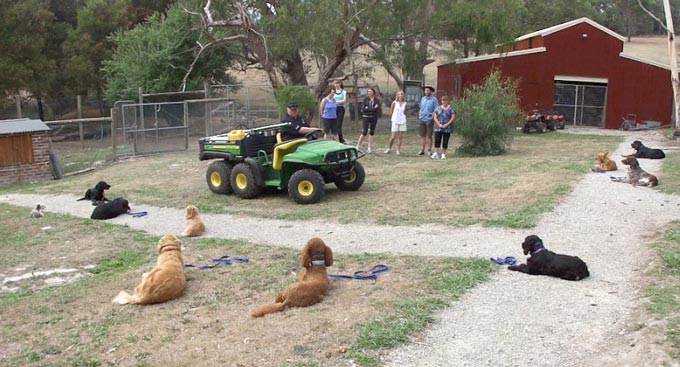
Above:This picture was taken from a video on our Facebook page tracking the training and improvement of dogs attending a 5 day Animal-Assisted Therapy Course conducted by Lead The Way and Alpha Canine Professional. Four of the seven dogs attending the course were not familiar with Alpha's methods, but as the course progressed these dogs improved at a rapid rate. The principles and methods developed within Alpha Canine R&Dactive are validated under distraction for use in real-life scenarios.
Conclusion
To allow a 'happy' puppy or dog to actively ignore their owner, or even worse, teach them that it is acceptable to do this during obedience or behavioural modification, is nothing more than trouble waiting to happen.
Again, if we simply ignore bad behaviour and reward good behaviour, how does the pup or dog ever learn not to be bad in the first place?
Puppies, in particular, need guidance and clear leadership they need someone to look up to, someone to follow and someone to teach them right from wrong someone they respect and trust. Owners need to be taught methods that promote these outcomes, not methods that turn everything into simplistic games.
Teaching puppies to listen and behave, with contrasting corrections, does not break their spirit or take the precious moments of fun and play out of the overall learning equation.
In fact, it enhances a positive relationship between the owner and their dog, and will remove the majority of life's challenges that will eventually affect the adult dog's behaviour. If you can't control your puppy or younger dog, why would this suddenly change as it matures into an adult dog? Puppies don't magically grow out of their pushy and demanding behaviours they can actually grow into them and get worse as they get older.
The maturing process can have a dramatic affect on your dog's behaviour, especially if it is pushy, demanding and generally out-of-control. This last point is every bit as relevant to happy and friendly pups and dogs, not just fearful, shy or aggressive pups and dogs. Many, many dog owners relate to us that "he's never done that before" and also state that "we yelled and screamed at him to stop, but he just ignored us".
You would be amazed at how many happy, but poorly trained dogs develop aggression or anxiety issues as an over-reaction to a change in their surroundings, family situation or a whole swag of other reasons we hear them all.
Methods that are focused more on theory than demonstration, and are over-reliant on food rewards, and refuse to correct unacceptable canine behaviour in a meaningful manner, do not, and cannot achieve the positive outcomes briefly outlined in this document.
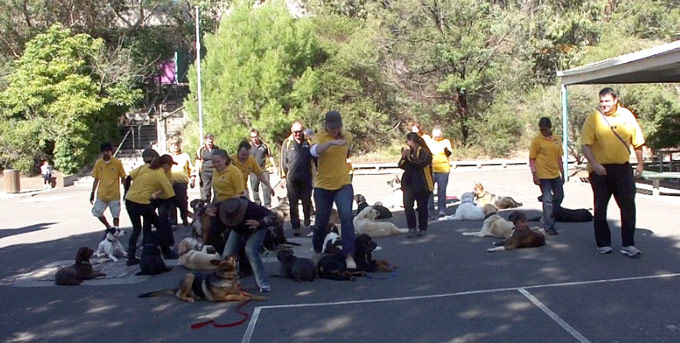
Above:This picture was taken from a video on our Facebook page showing Alpha Dog Training trainers and trainees working their own dogs after a regular Sunday morning session teaching obedience classes. They are moving through the group of dogs (holding a Drop Step-away) whilst clapping, cheering and jumping generally making a nuisance of themselves. There is a lot of fun and laughing as the dogs learn to hold position reliably under distraction many for the very first time under such mayhem.
Some of the newer dogs in this group have never confronted this level of distraction before and a couple of them are being rehabilitated for serious behavioural issues such as aggression and anxiety. There's also younger dogs (6 8 months old) and one dog that is being fostered by one of the trainers who regularly rehabilitates problem dogs so they can find new homes. Despite these dogs not being as experienced as many of the others, the learning from this distraction and confidence building exercise is invaluable.
This level of reliable obedience is relatively easy to achieve with balanced training methods that consistently achieve positive outcomes.
Dog owners should question all experts, even Alpha trainers, and ask to see demonstrations with real dogs so you can make an informed decision about the relevant and positive training methods you choose for your dog.
You can see many informative videos on our website that include examples of 'before & after' canine behaviour that has often been classified as difficult, if not impossible to manage or rehabilitate:

